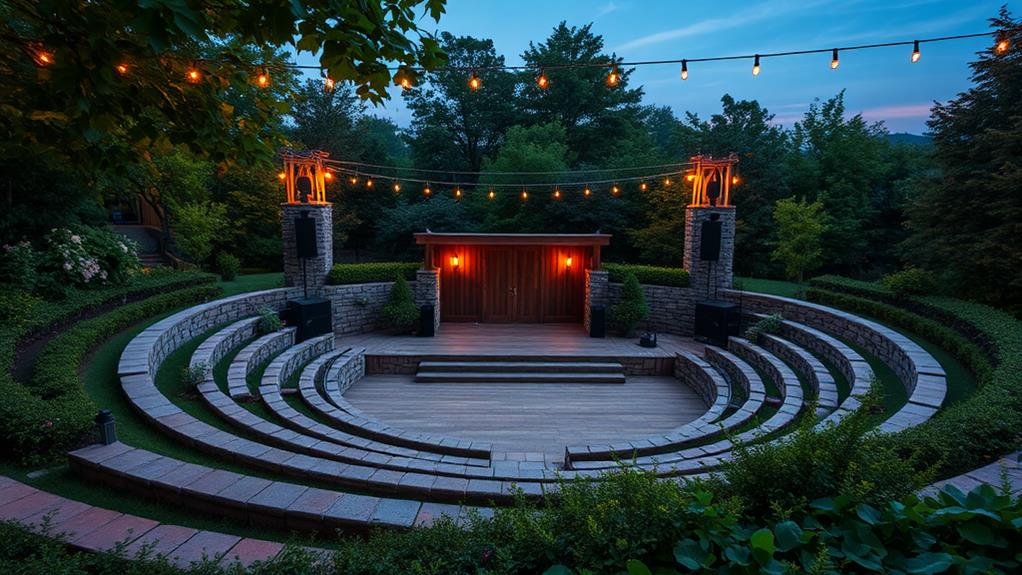Creating an outdoor theater in your backyard can transform your space into a magical venue for performances. Start by selecting a level area with natural elevation changes for optimal viewing. Build a sturdy stage using weather-resistant materials and incorporate tiered seating for audience comfort. Enhance the experience with strategic lighting design and a high-quality sound system. Weather-proof your stage with a sloped roof and retractable side panels. Invest in versatile set pieces and storage solutions to maximize flexibility. With careful planning and attention to detail, your backyard can become a captivating open-air theater that will delight performers and audiences alike.
Choosing the Perfect Stage Location

The foundation of a successful backyard outdoor theater lies in selecting an ideal stage location. Consider factors such as terrain, lighting, acoustics, and audience viewing angles when determining the best spot for your performance area.
A flat, level surface is crucial for the safety of performers and stability of equipment. Look for a space that offers natural elevation changes, which can be utilized to create tiered seating or a raised stage.
Assess the area's natural lighting conditions throughout the day, as this will impact performance times and the need for artificial lighting. Trees and structures can provide beneficial shade but may also cast unwanted shadows. Evaluate the acoustics by testing sound projection from potential stage locations. Avoid areas with excessive ambient noise from nearby streets or neighbors.
Ensure the chosen location allows for adequate audience seating and clear sightlines. Consider the sun's position during typical performance times to prevent glare for viewers. Additionally, factor in the proximity to power sources, storage areas, and any necessary backstage spaces.
Building a Sturdy Performance Platform
Constructing a robust performance platform is essential for ensuring the safety of performers and the longevity of your outdoor theater. Begin by selecting weather-resistant materials like pressure-treated lumber or composite decking.
For a standard 16' x 20' stage, use 4×4 posts as vertical supports, spaced 4 feet apart, and set them at least 2 feet into the ground with concrete footings.
Create a sturdy frame using 2×8 joists, spacing them 16 inches on center. Install 3/4-inch exterior-grade plywood for the stage surface, ensuring all seams align with joists. Apply a waterproof sealant to protect against moisture and extend the platform's lifespan.
Consider incorporating adjustable legs to accommodate uneven terrain and ensure a level surface. Install proper drainage beneath the platform to prevent water accumulation. For added stability, use cross-bracing between support posts.
Seating Arrangements for Your Audience

With a solid performance platform in place, attention turns to creating comfortable seating arrangements for your audience. Consider a tiered seating design to ensure optimal visibility for all spectators. Incorporate a mix of seating options, such as built-in benches, individual chairs, and even picnic-style blanket areas for a casual atmosphere.
For permanent seating, consider weather-resistant materials like treated wood, concrete, or recycled plastic. Built-in benches can be constructed along the perimeter of your theater space, maximizing capacity while maintaining a clean aesthetic. Portable folding chairs offer flexibility for varying audience sizes and can be easily stored when not in use.
Create designated aisles for easy access and safety. Ensure proper spacing between rows to allow comfortable legroom and easy movement. Consider adding cushions or padding to hard surfaces for extended comfort during longer performances.
Incorporate landscaping elements like terraced hillsides or retaining walls to create natural amphitheater-style seating. This approach not only provides excellent sightlines but also integrates seamlessly with your backyard's existing topography.
Lighting Design for Outdoor Drama
Effective lighting design transforms an outdoor theater from a simple backyard setup into a captivating performance space. Strategic illumination enhances the mood, directs audience attention, and creates visual depth for performances.
Begin with a basic lighting setup, including floodlights for general illumination and spotlights to highlight key areas or actors. LED lights offer energy efficiency and versatility, allowing for easy color changes to suit different scenes or productions.
Consider incorporating practical lights, such as lanterns or string lights, to add ambiance and define the performance area. These can also serve as safety lighting for audience members. Use dimmer switches to control light intensity and create dramatic effects.
For more advanced setups, explore wireless DMX systems that allow for programmable lighting cues controlled via smartphone or tablet.
Weather-resistant fixtures are essential for outdoor use. Protect electrical connections from moisture and ensure all equipment is properly grounded. Experiment with uplighting on trees or structures to add depth and create interesting shadows.
Sound Systems for Open-Air Theaters

Sound systems for open-air theaters present unique challenges and opportunities. Unlike indoor venues, outdoor spaces must contend with ambient noise, weather conditions, and varying acoustics. To overcome these obstacles, a carefully designed audio setup is crucial.
Wireless systems are often preferred for their flexibility and minimal visual impact. High-quality, weather-resistant speakers should be strategically placed to ensure even sound distribution across the audience area. Consider using line array systems for larger spaces, as they provide better sound projection and clarity over long distances.
Subwoofers can enhance low-frequency response, adding depth to musical performances and sound effects. For dialogue-heavy productions, prioritize vocal clarity through proper microphone selection and placement. Lapel or headset microphones are ideal for actors, while shotgun microphones can capture ambient sounds.
Implement a digital mixing console for precise control over multiple audio channels. This allows for real-time adjustments to compensate for changing environmental conditions. Additionally, incorporate a robust monitoring system for performers, ensuring they can hear themselves and other audio cues clearly.
Weather-Proofing Your Backyard Stage
A backyard stage's longevity and performance quality hinge on its ability to withstand various weather conditions. To protect your outdoor theater investment, consider implementing comprehensive weather-proofing strategies.
Start by selecting durable, weather-resistant materials for your stage construction. Pressure-treated lumber, composite decking, or marine-grade plywood are excellent choices for the stage floor and support structures. Apply water-sealant coatings to wood surfaces regularly to prevent rot and warping.
Install a sturdy, sloped roof to shield performers and equipment from rain and direct sunlight. Use weather-resistant roofing materials like metal panels or polycarbonate sheets. Ensure proper drainage to prevent water accumulation.
Incorporate retractable side curtains or panels to protect against wind and light rain while maintaining an open-air feel. Choose waterproof, UV-resistant fabrics designed for outdoor use.
Elevate electrical components and use weatherproof outlets, junction boxes, and cable conduits to safeguard against moisture damage. Install a proper grounding system to protect against lightning strikes.
Implement a drainage system around the stage area to prevent water pooling and soil erosion. Use gravel or permeable pavers to improve water absorption and reduce mud formation.
Set Design and Storage Solutions

For a successful backyard outdoor theater, thoughtful set design and efficient storage solutions are crucial. Consider versatile and modular set pieces that can be easily reconfigured for different productions. Lightweight materials like PVC pipes, fabric, and foam boards are ideal for creating portable backdrops and props.
Incorporate multi-functional elements, such as benches that double as storage units or foldable screens that can be used as both scenery and backstage partitions.
Weatherproof storage is essential for protecting costumes, props, and equipment. Invest in waterproof containers and trunks that can be securely locked when not in use. Consider building a small shed or repurposing a garden structure to serve as a dedicated storage area. Install shelving units and hanging racks to maximize vertical space and keep items organized.
For larger set pieces, create a system of pulley-operated backdrops that can be easily raised and lowered. Utilize collapsible furniture and stackable seating to minimize storage requirements. Implement a color-coding system for props and costumes to streamline set-up and tear-down processes. With careful planning and innovative solutions, your backyard theater can maintain professional-quality productions while efficiently managing space and resources.
Landscaping for Theatrical Ambiance
To create a truly immersive outdoor theater experience, thoughtful landscaping plays a crucial role in setting the stage and enhancing the overall ambiance. Strategic placement of plants, trees, and shrubs can frame the performance area, provide natural wings, and create a lush backdrop. Consider using evergreen trees for year-round screening and deciduous trees for seasonal interest.
Incorporate lighting into the landscape design to highlight key features and create dramatic effects. Use uplighting on trees, path lights to guide audience members, and accent lighting on architectural elements. Water features, such as fountains or small ponds, can add a soothing ambiance and mask unwanted noise.
Choose plants that complement the theatrical atmosphere, such as ornamental grasses for movement, fragrant flowers for sensory appeal, and sculptural plants for visual interest. Create levels and depth in the landscape using terracing or raised beds to mimic theater-style seating. Lastly, consider the practicality of maintenance and seasonal changes when selecting plants and hardscape materials to ensure your outdoor theater remains an inviting space throughout the year.
Frequently Asked Questions
How Can I Obtain Permits for Hosting Public Performances in My Backyard?
To obtain permits for hosting public performances in your backyard, contact your local city or county government's permitting department. They can provide information on zoning regulations, noise ordinances, and required licenses for public events on private property.
What Insurance Considerations Should I Keep in Mind for Outdoor Theater Events?
Coincidentally, insurance is crucial for outdoor events. Consider liability coverage for accidents, property damage protection, and event cancellation insurance. Consult with an insurance agent specializing in entertainment or special events to ensure comprehensive coverage for your specific needs.
How Do I Manage Noise Complaints From Neighbors During Performances?
To manage noise complaints from neighbors during performances, communicate proactively about event schedules, adhere to local noise ordinances, use sound-dampening equipment, limit performance duration and frequency, and consider inviting neighbors to attend or participate in events.
Are There Copyright Issues When Performing Plays in a Backyard Theater?
Navigating copyright waters can be treacherous. Generally, public performances of copyrighted plays require licensing, even in backyard theaters. Contact the play's publisher or a licensing agency to obtain necessary permissions and avoid legal complications.
How Can I Involve Local Schools or Community Groups in My Backyard Productions?
Engaging local schools and community groups in backyard productions can be achieved by offering workshop opportunities, holding open auditions, collaborating on set design, or inviting drama clubs to participate. This fosters community involvement and enhances the theatrical experience.
Conclusion
As the curtain falls on backyard theater renovation, a world of dramatic possibilities unfolds. From the whisper of wind through carefully placed props to the glow of strategically positioned lights, every element breathes life into outdoor performances. With a dash of creativity and a stroke of ingenuity, suburban lawns transform into Shakespearean stages, where neighbors become thespians and fences frame fantastical worlds. The backyard theater stands as a testament to the enduring magic of live performance.

